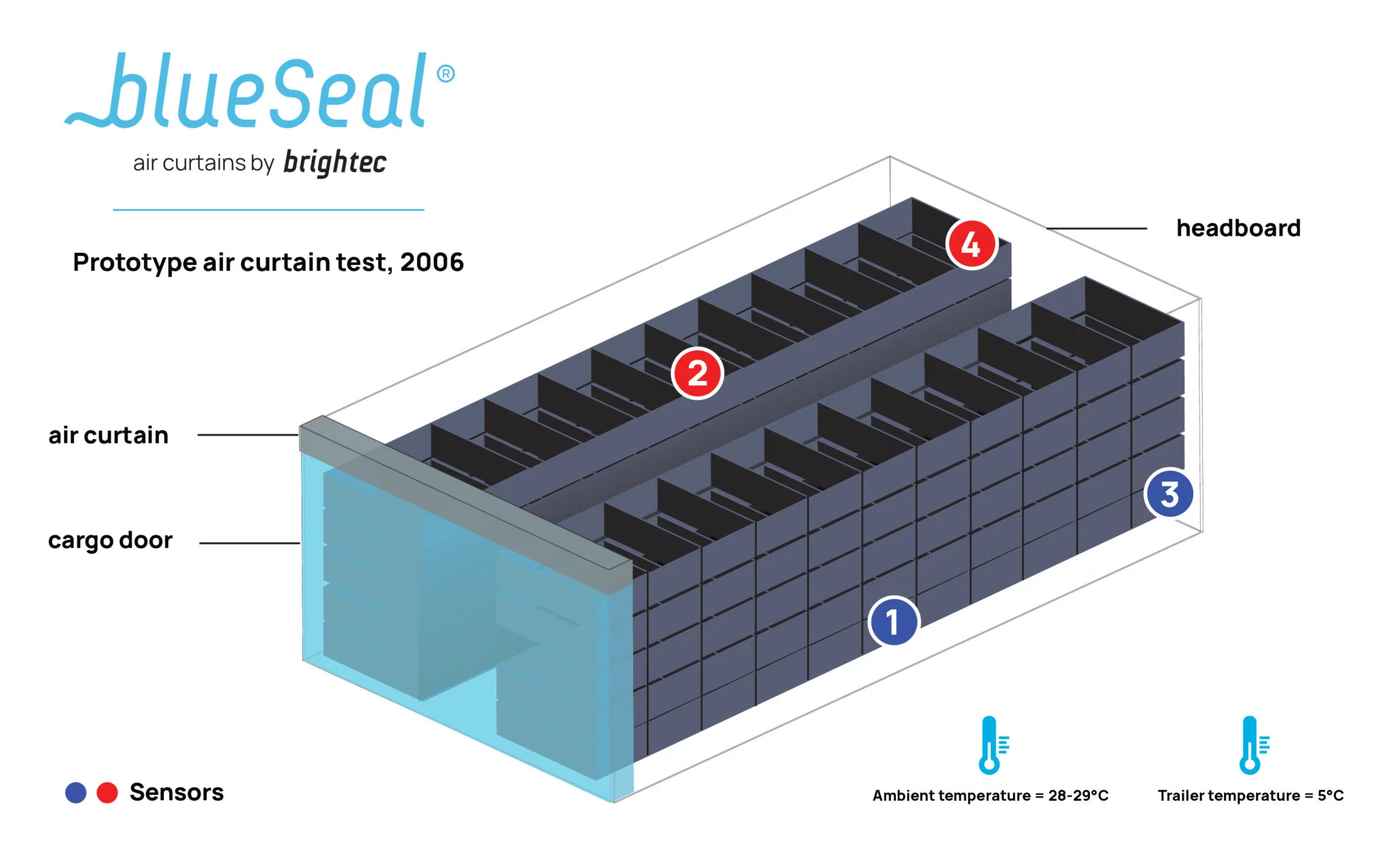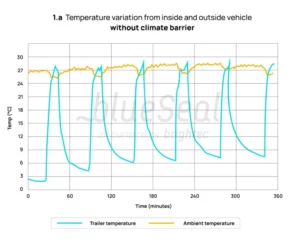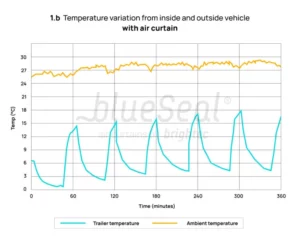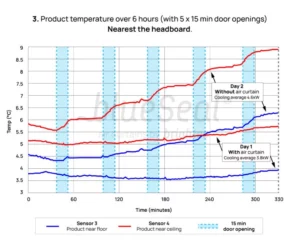
The origin of BlueSeal air curtains for transport
In this blog, Brightec founder Hans Opdam discusses the research project that led to the development of commercial vehicle air curtains during his time at Econcern, a now defunct company specialising in renewable energies. This became the working model for BlueSeal® air curtains.




The brief
In 2005, Econcern proposed a new refrigerated truck concept using eutectic refrigeration as a more energy-efficient means of transporting cold produce. The key benefit of eutectic refrigeration is that it requires no diesel fuel to operate, and can therefore provide a zero-emission solution to transporting cold goods.
The use of such a system normally requires a heavy weight of eutectic mass in which cold is stored to control the temperature in the loading space. Eutectic refrigeration has a reduced cooling energy (kWh/kg) against alternative diesel-based methods of refrigeration, which led us to identify solutions for preventing energy-loss at the most vulnerable stages of the cold chain.
The main cause of this energy loss is experienced during door openings. We found that our eutectic truck had difficulties maintaining the desired temperatures in the vehicle with multi stop deliveries, therefore it became paramount to find a solution that mitigates the cold loss and heat entrance during door openings.
In the pharmaceutical and food industries especially, cargo areas must maintain a consistent temperature to ensure that these goods are not compromised.
“A significant number of health products (vaccines, insulin, labile blood products, biotechnology products, tissue, organs etc.) are heat-sensitive and a change in their storage temperature can render them unusable, inefficient, even dangerous. Among the top 10 medicines sold across the world, only one does not have any specific temperature requirements. Confronting the issues raised with regards to the temperature control of these health products throughout the distribution chain is essential, with health and economic factors being the priority.” – The International Institute of Refrigeration, 30th Informatory Note on Refrigeration Technologies / January 2016
Previously, refrigerated vehicles have addressed this problem through the use of PVC curtains – creating a physical barrier between internal and external climates. While this offers a sound solution in principle, PVC curtains suffer from a range of disadvantages in their real-world application.
It became apparent from operators that drivers would commonly manoeuvre physical curtains to one side during loading and unloading, rendering them obsolete during the most critical point in the cold chain. Furthermore, these curtains would seldom be replaced when broken and would require additional (and often overlooked) cleaning to meet hygiene standards.
It soon became clear that a more elegant solution would be required to remove this physical hindrance for drivers in order for the cold chain to remain intact, removing human intervention altogether with an obstruction-free barrier.
We found our solution in an air curtain in order to provide a more efficient way of preventing cold air from escaping. Within Econcern we developed an air curtain specifically for conditional transport. After extensive testing we came up with a first version, the predecessor of the current BlueSeal.
Testing the concept
The purpose of testing is two-fold:
1. Is the air curtain able to save energy and maintain a required indoor climate (air and product temperature) in a situation with many door openings?
2. Is the saving of energy with the help of an air curtain sufficient to make a eutectic cooling system feasible?
In order to simulate the conditions of the daily routine of a refrigerated vehicle, we used a refrigerated semi-trailer in a conditioned room with an ambient temperature of 28-29°C. The vehicle doors would be open for 15 minutes every hour over the course of 6 hours and we tested the temperature of the cargo throughout the loading space. The product required a cooling temperature of 4-5°C during transport which was maintained using eutectic cooling equipment, this would be operational when cargo doors are closed.
For this test, we simulated the transport of milk using 1 litre cartons of water over 22 stacked pallets weighing 400kg each, creating a total payload of 8800kg. During each door opening, 4 of these pallets would be removed from the cargo space and the remaining packs would be measured throughout the cargo area. After the 5th door opening 2 pallets were left in the cargo space.
Product temperatures on 8 pallets were measured in 2 cartons per pallet. In this report we are presenting results from 2 pallets: those nearest to the headboard and 8 metres from the cargo doors. These serve as an accurate cross section of the test as a whole.
On the first day we measured the cargo temperature with our BlueSeal air curtain prototype and on the second without a barrier. The objective was to measure the product temperature, the cargo space air temperature and the energy consumption required to return the vehicles internal temperature to 4-5°C.
Without air curtain
During 15-minute door openings the trailer’s internal air temperature rose to 28°C and at no point did the cargo return to its minimum required temperature, even following 45 minute periods where the doors would remain closed. In fact, the minimum air temperature after the 45 minute periods would continuously rise over the 6 hour period – from 0°C to 8°C following 5 door openings– figure 1a.
Cartons on pallets located in the centre of the trailer, approximately 8 metres from the doors, rose 0.8°C (from 5.2°C to 6.0°C) nearest the floor and 1.7°C (5.3°C to 7.0°C) on the pallets stacked nearest the roof, after 3 door openings– figure 2. During the fourth door openings, these pallets were driven outside.
Cartons on the pallets nearest the headboard rose 1.9°C (from 4.5°C to 6.4°C) nearest the floor and 3.1°C (5.7°C to 8.8°C) nearest the ceiling, after 5 door openings – figure 3.
It was observed that even after closing the doors the product temperature continued to increase. The cooling machine used a total of 26.5kWh (average 4.6kW, with average peak of 12kW) over the course of the 6 hours yet did not succeed at keeping the cartons at their minimum required temperature of 5°C. In a later simulation model Brightec ran in 2019, we deduced that 44kWh cooling energy would be required to avoid the temperature rising throughout the day.
With BlueSeal air curtain
Using the air curtain at the trailer door entrance, the internal air temperature of the trailer reached a maximum of 18°C by the end of the 6 hour period. The cooling equipment was able to limit the rise in minimum temperature from 0°C to 4.5°C – figure 1b. During the 45 minutes where the doors were closed, the product was returned almost consistently to its initial temperature – figure 2.
The carton placed on the pallet located in the middle of the trailer rose less than 0.1°C (from 3.8°C to 3.9°C) at a maximum rate of 0.3°C (from 3.9°C to 4.2°C) following 3 door openings – figure 2. During the fourth door opening, these pallets were driven outside. And on pallets nearest the headboard, pallets rose 0.3°C (from 3.7°C to 4.0°C) nearest the floor and 0.7°C (5.1°C to 5.8°C) nearest the ceiling – figure 3.
The cooling machine used a total of 21.8kWh (average 3.8kW, average peak 9.5kW) over the 6 hours with the air curtain, which required only 3.8kW to operate. Our 2019 simulation model taught us that we would require approximately 30kWh to avoid the temperature of the product rising during the 6 hours.
With BlueSeal air curtain
Using the air curtain at the trailer door entrance, the internal air temperature of the trailer reached a maximum of 18°C by the end of the 6 hour period. The cooling equipment was able to limit the rise in minimum temperature from 0°C to 4.5°C – figure 1b. During the 45 minutes where the doors were closed, the product was returned almost consistently to its initial temperature – figure 2.
The carton placed on the pallet located in the middle of the trailer rose less than 0.1°C (from 3.8°C to 3.9°C) at a maximum rate of 0.3°C (from 3.9°C to 4.2°C) following 3 door openings – figure 2. During the fourth door opening, these pallets were driven outside. And on pallets nearest the headboard, pallets rose 0.3°C (from 3.7°C to 4.0°C) nearest the floor and 0.7°C (5.1°C to 5.8°C) nearest the ceiling – figure 3.
The cooling machine used a total of 21.8kWh (average 3.8kW, average peak 9.5kW) over the 6 hours with the air curtain, which required only 3.8kW to operate. Our 2019 simulation model taught us that we would require approximately 30kWh to avoid the temperature of the product rising during the 6 hours.
Conclusions
The tests showed that under realistic conditions, the air curtain contributed significantly to energy saving and temperature conservation of the products. With the use of the air curtain, the extra eutectic mass can be very limited, making a eutectic cooling system economically feasible.
Using an air curtain, the cooling machine used ca. 18% less energy and was also able to control the temperature of the product. Without any climate barrier, the temperature of the goods rise at a considerably higher rate, despite the additional cooling energy use.
In a situation where the cooling machine was emitting sufficient power to maintain the product temperature at a constant, it was simulated that BlueSeal reduces energy use by 30-40%.
The tests demonstrate the critical function that an effective climate barrier provides in refrigerated transport. Perishable foodstuffs and pharmaceuticals are especially at risk of spoiling over multiple deliveries where items are exposed to outside temperatures. The air curtain provides a consistent and uninterrupted barrier during loading and unloading that keeps the cold chain intact, in a method that is hygienic, user friendly and beneficial to the energy costs of existing cooling equipment.
As a result of these conclusions and the potential for the commercial application of this technology, I formed the company Brightec to develop this product further as BlueSeal air curtains. Over the years Brightec R&D have refined and developed the efficiency of BlueSeal into the product we see today, with a highly positive reception from both companies and operators. BlueSeal now operates as a leading solution for vehicle climate control in over 22 countries worldwide, with a range of BlueSeal products suited to different applications – including BlueSeal Compact that is designed for optimum efficiency in vans and smaller vehicles.
Figures
Figures 1a and 1b : Temperature of the inside air measured over 6 hours with 6 x 15 min door openings without any barrier (figure 1a) and with the air curtain (1b) above the rear doors. Ambient temperature indicates 28-29°C.
Figure 2 : Temperature course inside two 1 litre cartons of water during 4 hrs with 3 x 15 min of door opening without and with air curtain. Cooling machine operates at averages of 4.6kW and 3.8kW respectively. Cartons are located on the same pallet approx. 8 metres from the rear doors: sensor 2 shows carton temperature nearest ceiling, sensor 1 shows carton temperature nearest the floor.
Figure 3 : Temperature course inside two 1 litre cartons of water during 6 hrs with 5 x 15 min of door opening without and with air curtain. Cooling machine operates at an average of 4.6kW and 3.8kW respectively. Two cartons are located near headboard on the same pallet approx. 13 metres from the rear doors: sensor 4 shows carton temperature nearest ceiling, sensor 3 shows carton temperature nearest the floor.
For more information on BlueSeal air curtains, please contact our Brightec consultants at info@brightec.nl